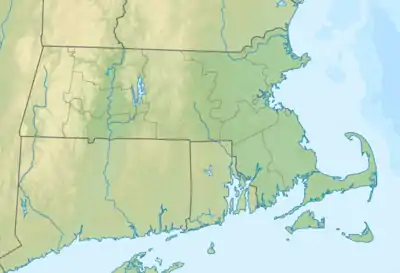Portland Formation
The Portland Formation is a geological formation in Connecticut and Massachusetts in the northeastern United States.[1] It dates back to the Early Jurassic period.[2] The formation consists mainly of sandstone laid down by a series of lakes (in the older half of the formation) and the floodplain of a river (in the younger half). The sedimentary rock layers representing the entire Portland Formation are over 4 kilometres (2.5 mi) thick and were formed over about 4 million years of time, from the Hettangian age (lower half) to the late Hettangian and Sinemurian ages (upper half).[3]
| Portland Formation Stratigraphic range: Hettangian-Sinemurian ~199–195 Ma | |
|---|---|
| Type | Geological formation |
| Unit of | Newark Supergroup |
| Sub-units | Turners Falls Sandstone & Mount Toby Formation |
| Lithology | |
| Primary | Sandstone |
| Other | Mudstone, siltstone, limestone |
| Location | |
| Coordinates | 42.3°N 72.5°W |
| Approximate paleocoordinates | 24.0°N 18.6°W |
| Region | Connecticut, Massachusetts |
| Country | |
| Extent | Deerfield & Hartford Basins |
 Portland Formation (the United States)  Portland Formation (Massachusetts) | |
In 2016, the paleontologist Robert E. Weems and colleagues suggested the Portland Formation should be elevated to a geological group within the Newark Supergroup (as the Portland Group), and thereby replacing the former name "Agawam Group". They also reinstated the Longmeadow Sandstone as a formation (within the uppermost Portland Group); it had earlier been considered identical to the Portland Formation.[4]
Vertebrate paleofauna
Dinosaur coprolites located in Massachusetts, USA.[2] Ornithischian tracks located in Massachusetts and Connecticut, USA.[2] Theropod tracks located in Massachusetts and Connecticut, USA.[2] Prosauropod tracks located in Massachusetts and Connecticut, USA.[2]
| Dinosaurs | ||||||
|---|---|---|---|---|---|---|
| Genus | Species | Location | Stratigraphic position | Material | Notes | Images |
| Anchisaurus[2] | A. polyzelus[2] |  | ||||
| Podokesaurus[2] | P. holyokensis | Connecticut[2] | Partial postcranial skeleton.[5] | All known remains of this species have been destroyed. |  | |
See also
- List of dinosaur-bearing rock formations
References
- Portland Formation - USGS
- Weishampel et al., 2004, pp.530–532
- Olsen, P.E. (2002). "STRATIGRAPHY AND AGE OF THE EARLY JURASSIC PORTLAND FORMATION OF CONNECTICUT AND MASSACHUSETTS: A CONTRIBUTION TO THE TIME SCALE OF THE EARLY JURASSIC". Archived from the original on 2018-11-28. Retrieved 2017-07-07.CS1 maint: bot: original URL status unknown (link). Session No. 26 Studies of Depositional Systems and Sedimentary Rocks: In Honor of Edward Scudder Belt. 37th Annual Meeting (March 25-27, 2002).
- Weems, R. E.; Tanner, L. H.; Lucas, S. G. (2016). "Synthesis and revision of the lithostratigraphic groups and formations in the Upper Permian?–Lower Jurassic Newark Supergroup of eastern North America". Stratigraphy. 13 (2): 111–153.
- "Table 3.1," in Weishampel et al., 2004, p.48
Bibliography
- Weishampel, David B.; Peter Dodson, and Halszka (eds.) Osmólska. 2004. The Dinosauria, 2nd edition, 1–880. Berkeley: University of California Press. Accessed 2019-02-21. ISBN 0-520-24209-2
